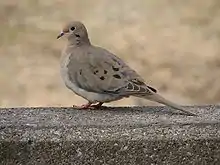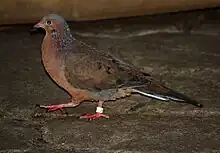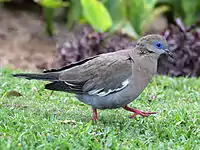Zenaida doves
The zenaida doves make up a small genus (Zenaida) of American doves in the family Columbidae.
| Zenaida doves | |
|---|---|
 | |
| Mourning dove (Zenaida macroura) | |
| Call of a mourning dove | |
| Scientific classification | |
| Domain: | Eukaryota |
| Kingdom: | Animalia |
| Phylum: | Chordata |
| Clade: | Dinosauria |
| Class: | Aves |
| Order: | Columbiformes |
| Family: | Columbidae |
| Subfamily: | Columbinae |
| Genus: | Zenaida Bonaparte, 1838 |
| Type species | |
| Zenaida amabilis[1] Bonaparte, 1838 | |
| Species | |
|
See text. | |
| Synonyms | |
| |
The genus was introduced in 1838 by French naturalist Charles Lucien Bonaparte.[2] The name commemorates his wife, Zénaïde Laetitia Julie Bonaparte, niece of Napoleon Bonaparte.[3] The type species is the Zenaida dove, Zenaida aurita.[4]
Systematics
DNA sequence analysis[5] confirms that the white-winged and West Peruvian doves are the most distinct and that they should be treated as distinct species. Relationships among the other species are quite unequivocal, too; what is not quite clear is whether the Galapagos dove is most closely related to the zenaida dove (as tentatively indicated by morphology) or to the eared and mourning doves (as suggested by DNA sequences — although with a very low confidence level – and, most robustly, biogeography).
| ||||||||||||||||||||||||||||||
| Cladogram showing the position of Zenaida among its closest relatives.[6][7] |
Extant species
The genus contains seven species:[8]
| Image | Scientific name | Common name | Distribution |
|---|---|---|---|
.jpg.webp) | Zenaida asiatica | White-winged dove | Southwestern United States through Mexico, Central America, and the Caribbean |
 | Zenaida auriculata | Eared dove | South America from Colombia to southern Argentina and Chile, and on the offshore islands from the Grenadines southwards |
_RWD.jpg.webp) | Zenaida aurita | Zenaida dove | Caribbean and the tip of the Yucatán Peninsula |
_-Espanola_-Gardner_Bay2.jpg.webp) | Zenaida galapagoensis | Galápagos dove | Galápagos, off Ecuador |
 | Zenaida graysoni | Socorro dove | Socorro Island in the Revillagigedo Islands; extinct in the wild |
 | Zenaida macroura | Mourning dove | Most of Canada and USA to south central Mexico, Bermuda, the Bahamas, the Greater Antilles, and Panama |
 | Zenaida meloda | West Peruvian dove | from southern Ecuador to northern Chile |
See also
- Passenger pigeon, a similar-looking extinct species
References
- "Columbidae". aviansystematics.org. The Trust for Avian Systematics. Retrieved 2023-08-05.
- Bonaparte, Charles Lucian (1838). A Geographical and Comparative List of the Birds of Europe and North America. London: John Van Voorst. p. 41.
- Jobling, James A (2010). The Helm Dictionary of Scientific Bird Names. London: Christopher Helm. p. 414. ISBN 978-1-4081-2501-4.
- Peters, James Lee, ed. (1937). Check-List of Birds of the World. Vol. 3. Cambridge, Massachusetts: Harvard University Press. p. 86.
- Johnson, Kevin P. & Clayton, Dale H. (2000). "A molecular phylogeny of the dove genus Zenaida: mitochondrial and nuclear DNA sequences" (PDF). Condor. 102 (4): 864–870. doi:10.1650/0010-5422(2000)102[0864:ampotd]2.0.co;2.
- Banks, R.C.; Weckstein, J.D.; Remsen Jr, J.V.; Johnson, K.P. (2013). "Classification of a clade of New World doves (Columbidae: Zenaidini)". Zootaxa. 3669 (2): 184–188. doi:10.11646/zootaxa.3669.2.11.
- Johnson, K.P.; Weckstein, J.D. (2011). "The Central American land bridge as an engine of diversification in New World doves". Journal of Biogeography. 38: 1069–1076. doi:10.1111/j.1365-2699.2011.02501.x.
- Gill, Frank; Donsker, David; Rasmussen, Pamela, eds. (2020). "Pigeons". IOC World Bird List Version 10.1. International Ornithologists' Union. Retrieved 2 March 2020.